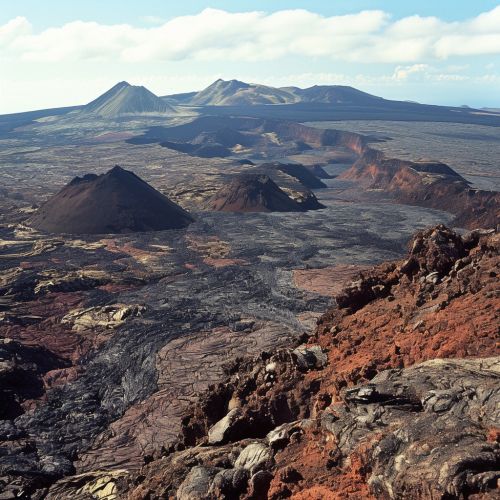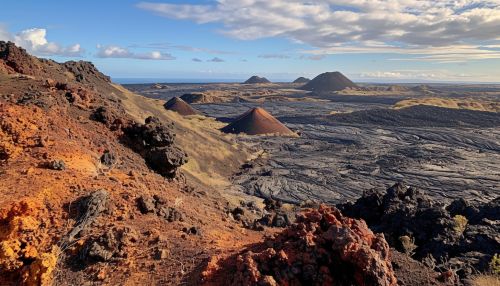Volcanic fields
Introduction
A volcanic field, also known as a volcanic area or volcanic region, is a region of the Earth's crust that is prone to volcanic activity. These fields are characterized by the presence of numerous volcanoes, volcanic vents, and other volcanic features spread over a large area. Volcanic fields are not to be confused with volcanic belts, which are linear chains of volcanoes typically associated with tectonic plate boundaries.


Formation
Volcanic fields are formed through a process known as volcanic eruption. This process involves the release of molten rock, or magma, from beneath the Earth's crust. When this magma reaches the surface, it can form a variety of volcanic features, including volcanoes, volcanic vents, and lava fields. The formation of a volcanic field typically involves numerous eruptions over a long period of time, often spanning millions of years.
Types of Volcanic Fields
There are several types of volcanic fields, each characterized by different types of volcanic activity and features.
Monogenetic Volcanic Fields
Monogenetic volcanic fields are composed of volcanoes that each erupt only once. Each volcano in a monogenetic field is fed by a separate magma source, and once this source is depleted, the volcano becomes extinct. Examples of monogenetic volcanic fields include the Auckland volcanic field in New Zealand and the San Francisco volcanic field in the United States.
Polygenetic Volcanic Fields
Polygenetic volcanic fields are composed of volcanoes that can erupt multiple times. These volcanoes are fed by a persistent magma source that can replenish itself over time, allowing for repeated eruptions. Examples of polygenetic volcanic fields include the Yellowstone volcanic field in the United States and the Campi Flegrei in Italy.
Lava Fields
Lava fields, also known as lava plains, are a type of volcanic field characterized by extensive flat areas covered in solidified lava. These fields are formed by highly fluid lava that spreads out over a large area before cooling and solidifying. Examples of lava fields include the Holuhraun in Iceland and the Columbia River Basalt Group in the United States.
Distribution
Volcanic fields can be found all over the world, on every continent and in every type of tectonic setting. They are most common in regions with active volcanism, such as the Ring of Fire around the Pacific Ocean, the East African Rift, and the Mid-Atlantic Ridge. However, volcanic fields can also be found in regions of past volcanic activity, such as the basaltic plains of Victoria in Australia and the Snake River Plain in the United States.
Importance
Volcanic fields are of great importance in a variety of fields, including geology, volcanology, and environmental science.
Geological Importance
From a geological perspective, volcanic fields provide valuable insights into the Earth's interior. The composition of the magma that forms the volcanoes and other features in a volcanic field can reveal information about the mantle and crust beneath the field. In addition, the age and distribution of the volcanic features can provide clues about the tectonic history of the region.
Volcanological Importance
From a volcanological perspective, volcanic fields are important for understanding the processes of volcanic eruption and magma formation. The variety of volcanic features found in a field can reveal a great deal about the types of eruptions that have occurred there and the types of magma involved. In addition, studying volcanic fields can help scientists predict future volcanic activity and mitigate the risks associated with it.
Environmental Importance
From an environmental perspective, volcanic fields can have both positive and negative impacts. On the positive side, volcanic soils are often highly fertile, making volcanic fields important for agriculture. On the negative side, volcanic eruptions can have devastating effects on the environment, including air pollution, habitat destruction, and climate change.
